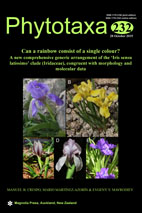Abstract
When treated in a broad sense, Iris (the ‘rainbow-flowers’) is one of the most diverse and well-known genera in the Asparagales. However, recent conventional phylogenetic and three-taxon statement re-treatments of the molecular data (cpDNA) for the irises (‘Iris sensu latissimo’ clade) showed that the obtained patterns of relationships appeared to be fully congruent to the narrow taxonomical arrangement of Iris (sensu stricto) to include only the bearded irises. Given this, we propose a new taxonomic arrangement of the rainbow-flowers with at least 25 previously recognised infrageneric taxa here accepted at the generic rank, of which 19 have already been treated as separate genera by different authors in the past. Morphological, phytochemical, karyological, distributional and molecular data are discussed which support the newly proposed system. Five genera and one section are described as new, 1 genus is amended, and 114 new nomenclatural combinations (2 genera, 3 sections, 1 series, 86 species, 14 varieties and 8 nothospecies) are established to accommodate the accepted names to the new generic system. Morphological descriptions and nomenclatural types are reported for each accepted genus, with types of four genera being designated here for the first time. Tentative distribution maps of relevant taxa, and illustrations of the most reliable morphological characters are included for the accepted genera. Principal synonyms and publication details are shown, and accepted infrageneric taxa are only referred to when previous information is not available. A key is also reported for genera identification. Our proposal mostly accords with the traditional distinction of groups currently in use by horticulturists, and it is favoured against an alternative treatment of an expanded Iris which renders a highly heterogeneous genus.

